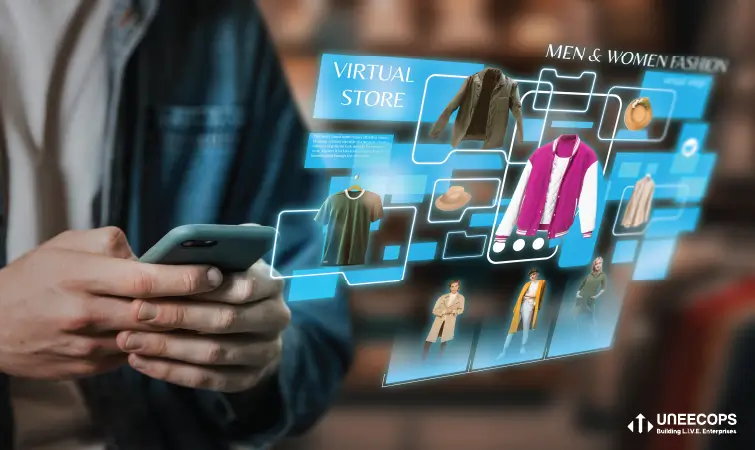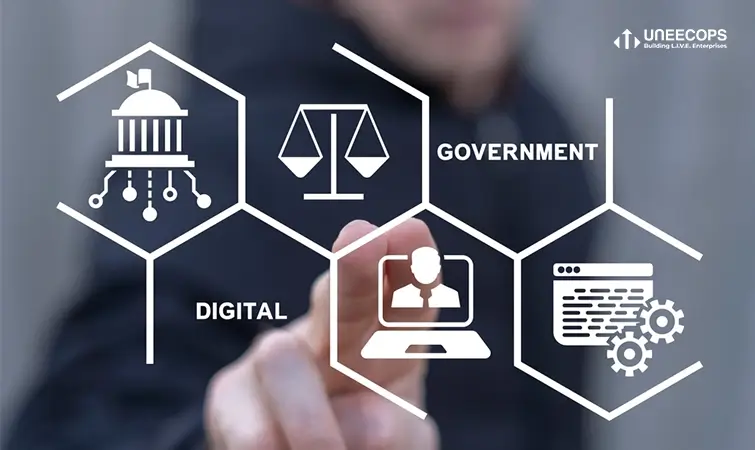Through digital retail transformation, the thick glass in which technology, customers, and experiences used to be sealed is taken down, making the world of retail dynamic. Applying the following strategies, from clear-room shops to retailers, everyone is undertaking increasingly digitalized steps to compete in the market and meet present consumer needs. This article discusses the basic concepts of digital transformation in retail, its impact, and its views on the development.
Key Components of Digital Transformation in Retail
E-commerce and Omnichannel Strategies
- The advent of e-commerce has seen the largest shift towards digital transformation in retail. No more physical stores for the retailers, they have entered into a realm where customers interact with retailers seamlessly through several touchpoints and non-touch points.
- The implementation of these omnichannel strategies along with the digital retail transformation makes it possible for customers to be able to browse, buy, and return goods across any channel they wish while enjoying the same consistent experience.
Customer Experience and Personalization
- Consumer needs for individualization and personalized offerings are on the rise. Through utilizing digital technologies, retailers can analyze where their clients’ activities, interests, and spending patterns have gone. This information allows merchants to enhance marketers’ campaigns, improve their propositions to customers, and offer discounts to specific customers, thus enabling better enhancement of digital transformation in retail.
- In this aspect of personalization, artificial intelligence, and machine learning come into play since retailers can forecast the particular needs of the customers and present them with relevant information.
Supply Chain and Inventory Management
- The modernization process in the retail sector is also changing the provision of services regarding the management of supply chains and inventories. With the help of IoT, RFIDs, and blockchain advances, one can track when a product is out of stock, its location, and also the status of the supply chain. Such visibility allows retailers to control how much stock they keep, cut down any unnecessary stock, and ensure that customers’ orders are fulfilled on time.
- The Fourth Industrial Revolution has made it possible to integrate computerized systems into retail with one of the inventions including automated inventory systems that can reorder goods as soon as demand depletes preventing both stock-outs and stock overages.
AI and Automation
- The availability of AI in retail has transformed the retail industry as jobs such as customer service attendance, inventory management, as well as the setting of prices become automated. AI Driver Chatbots have been developed such that they assist customers with real-time inquiries to provide help in achieving transactions effectively on a 24-hour basis.
- Again, there is an enhancement of operational effectiveness through the automation of techniques for conducting business in the retail segment. Storage drones can track inventory, complete orders and handle deliveries. This reduces people’s mistakes and improves the speed of things.
Data-Driven Decision Making
- Big data drives digital transformation in the retail business. Evaluation of data in strategic decision-making has increasingly been diverse among retailers. Be it in trend analytics, decisions in pricing strategy improvement, or any other areas of operations, information helps retailers in flexibility.
- From predictive analytics, many retail business owners have adopted the transformation as it aids in predicting what the markets are looking for, what consumers demand, and even what could potentially disrupt business and as such taking the necessary measures.
Mobile and Social Commerce
- Mobile commerce is on the rise as most consumers are adapting to smartphones and tablets in shopping. Retailers are modifying web-based applications concerning smaller screen-oriented devices to offer both quick and simple-to-use services.
- Social commerce, selling executed through social media platforms, is yet another growing trend. In this unique world of retailing, where unlike before we can see bricks and mortar retailers leveraging sites like Instagram and Facebook to gain traction through influencer marketing and targeted ads to sell more.
The Reasons for the Growth of e-Transformation in Retail
Enhanced Customer Journey
Digital retail transformation focuses on providing a faster and better shopping experience, higher customer satisfaction, and loyalty to the customer.
Increased Efficiency and Decreased Employee Costs
Robotic processes and big data – which are some of the aspects of retail e-transformation – ease business processes enabling appropriate labor and operational costs to be cut down. More productive inventory turnover coupled with enhanced visibility of the supply chain also helps achieve cost reductions.
Wider Accessibility and Deeper Market Expansion
With the help of e-commerce and omnichannel retailing, however, it is possible to tap into larger market segments to enhance presence both on regional and international levels.
Speedy Enabling Functions and Innovative Approach
Digital tools enhance the speed with which merchants respond to the dynamic market enabling them to change the existing products, bring new goods into the market, and use out-of-box approaches to cut ahead of rivals.
The Future of Digital Transformation in Retail Marketing
As the innovative developments progress, it is most likely that retail business operations will be even more digitized. For instance, augmentation reality, virtual reality, and the Internet of Things (IoTs) will contribute to further improvements in customer journeys and effectiveness of the operations.
Augmented and virtual reality lets customers imagine shopping in a whole new way and lets them see (in real life and VR) what they are going to buy even before making a purchase. Smart solutions based on the Internet of Things will allow advertisers to increase their customer appeal and even connect devices and systems which will transform conventional stores into active areas that provide varied services to individuals.
Also, in tandem with the increase of a need for digital transformation in retail stores, AI along with machine learning will evolve to support extensive personalization. Besides, other models well known as subscription services or even experiential retail are likely to be pursued by retailers to market customers in another approach.
Digital Disruption in Retail in 2024 and Future
| Traditional Retailers | Store of the future | Examples | ||
| Where to Play? | ||||
| Segmentation | Adopt mass and demography based segmentation | Data Analytics for microsegmentation • Provide personalized offerings • Targeted communication | Advanced AI based analytics to create customer microsegments | |
| Positioning | Compete on price and quality | Offer additional services & facilities • Leisure provisions and shopping environment • Convenience | Theme-based digitally enhanced experiential stores | |
| Strategy | ||||
| Operating Formats | Predominantly focus on Brick & Mortar layout | Disruptive & innovative formats aided by digital initiatives to expand reach (Omni channel approach) | On-demand grocery delivery | |
| Business Models | Adopt single dimensional business models | Disruptive business models using digital enablers | Subscription model, Hypermarket model | |
| Front-end | ||||
| Customer Experience | • Emphasize functionality across touchpoints • Focus on in-store journey | Holistic physical and digital experience across entire customer journey | Smart mirrors for providing virtual trials to shoppers | |
| Merchandizing | Focus on customer engagement through: • Visual Merchandizing • Store layouts | Digital merchandizing techniques – • Virtual fitting rooms • Digital kiosks • Augmented Reality | Virtual trial rooms and 3D try on facility | |
| Loyalty Programs | Focus on: • Traditional loyalty programs like stamps on cards led with a catchment-focus | Shift towards: • Mobile app based programs • Virtual reality tie ups • Blockchain based loyalty program | Block-chain based loyalty programs | |
| Back-end | ||||
| Supply Chain | Linear supply chains | Shift towards a dynamic, integrated supply network – Digital Supply Networks | “Always-on” agile supply chain | |
| Pricing and POS solutions | Rely on traditional pricing methods | • Advanced dynamic pricing strategies • Customized engagement and personalized deals for customers | Use of electronic shelf-edge technology | |
| Logistics & Warehousing | Traditional logistics and warehouse management | Shift to: • Shared logistics capabilities • Digitally enabled logistics services • Continuous automated monitoring | Drone based deliveries | |
| Finance | Conventional financial reporting and management | Shift towards: • Use of RPA to automate financial functions • IOT-enabled processes | Crypto currencies such as Bitcoins | |
| Procurement and Vendor Management | Focus on: • Traditional supplier customer relationships | Shift to: • Collaboration with vendors for success | Block-chain technology for contract management & supplier payments | |
| Assortment-mix & Planning | Decisions basis • Experience & judgement • Ad-hoc assortment prioritization • Historical baselines | Retailers use: • Data-driven algorithms for store’s assortment planning • Adopt predictive models & real-time forecasting • Use dark analytics | RFID chips to make supply chain more responsive | |
| People & Organization Structure | Traditional ways of training and managing resources • Adopted in isolation and based on historical values | Simplifying employee processes through automation • Digital retail transforming KPIs being used to measure and reward staff | Adoption of smart systems to manage staff shifts and checkout procedures | |
Resetting Retail with Tech of Tomorrow with Uneecops
Digital transformation in the retail industry isn’t a choice but a matter of survival for retailers and a reality in the modern competitive world. Taking appropriate steps and adopting new technologies will help the sellers to improve customer satisfaction, streamline processes, and maintain competitiveness. Nevertheless, such digital transformation in retail comes with its challenges, and practitioners will have to be careful in getting it successful, it is an area of great dynamism, and one has to be customer-centric every step of the way.
Uneecops brings a suite of end-to-end solutions that integrate and bind retail operations on a single platform. Our enterprise ERP, CRM, Analytics and Cloud offerings focus on consumer products, channels, services, sourcing, talent, and data. With the right technology, strategy, data, and level of agility, we enable retailers to find profitable growth in an ever-changing and challenging world.
Want to stay ahead in the retail game? Request a free consultation with our experts to explore how digital transformation can benefit your retail business.








